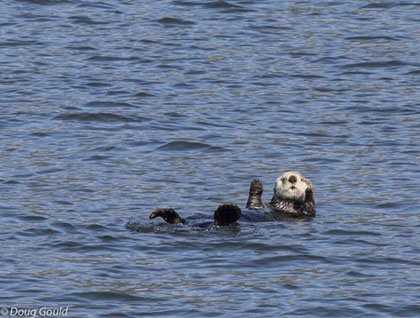Glacier Bay is an iconic destination, a keystone of Alaska’s natural history. Pristine, wild, and unspoiled are just a few words used to describe this giant basin. Carved thousands of years ago by ice thousands of feet thick, glaciers moved like slow motion juggernauts, pulverizing everything in their path, leaving the Earth’s crust deeply cleaved. As recently as 1750, the entire bay was filled with glacial ice. Since that time, the ice has receded and the ocean has filled the fjords, creating a bay that appears designed by nature to explore by small ship.
Guests aboard National Geographic Sea Bird enjoyed a quiet night as the ship was tied up at the National Park Service docks in Bartlett Cove. Before 0600, our Park Rangers and guides were aboard, and the order was given to cast off. It’s 52 nautical miles from the entrance of the bay to the Margerie Glacier at the north end, so an early start was in order to make the most of our daylight hours.
The weather was perfect, with clear skies and very calm seas. As the ship steamed north, guests with fresh coffee gathered on the bow and enjoyed views of sea otters, Steller’s sea lions, marbled murrelets, pigeon guillemots plus a variety of cormorants, loons, and ducks. During breakfast, expedition leader Larry Prussin introduced our two Park Rangers who will on board all day to interpret the sights and history of Glacier Bay.
As the breakfast dishes were cleared, the ship sailed passed Marble Island, haul out for Steller’s sea lions and a known haunt for puffins.
At about 10 a.m., a black bear was spotted up high on a cliff. It was far away but everyone did get a view, and the ship’s spotting scope was put to good use. Not 40 minutes later and only a few miles further north, a large, healthy brown bear was found ambling along a rocky beach. The skill of our bridge crew meant that we were able to maneuver quite close without disturbing the bear, thereby getting good views and photo opportunities. While he seemed to be foraging among the rocks, he found time to glance up at our ship with a suspicious eye, if only to let us know that he knew we were here.
The next stop was at a large nude dome of rock known as Gloomy Knob, poking about 1300’ above the water. The local rangers say that it got its name from the persistent shroud of fog or mist that hovers over the knob, but today clear blue skies prevailed, affording everyone excellent views of about six mountain goats that were grazing not far above sea level. Their ability to climb steep, sheer and almost smooth rocks was thrilling to watch, and once again, the wildlife of Glacier Bay was close enough to afford decent photos. Soon, it was time to head north towards our ultimate destination—Margerie Glacier. As we approached, out Tlingit guide Leonty Williams sang a special ceremonial song to honor the spirits of his culture that inhabit the glacier. According to tradition, Tlingit always sing to announce their arrival to their host. The song had the desired effect, as we were entertained with an hour of “white thunder” and crashing calvings from the glacier face.
The rest of the day was spent relaxing as National Geographic Sea Bird sailed south and returned to Bartlett Cove after dinner to drop off our park guides and have a chance for an evening constitution on shore. Another glorious day of adventure comes to a close.







